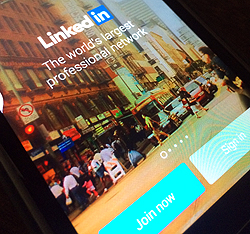Insight Marketing Blog
4 Steps to Effective Networking on LinkedIn
 With 259 million members, LinkedIn is the leading professional networking site.
With 259 million members, LinkedIn is the leading professional networking site.
It used to be that the sole way for busy professionals to connect involved hustling at networking events – donning nametags and making forced introductions over brunch buffets and stale coffee. Anyone who’s attended these events, often hosted by local business associations, can tell you that many eat up valuable time while producing few valuable connections.
This all changed with the advent of social media. Today, it’s as likely you’ll meet a prospective partner, vendor or client for the first time through posts, likes and comments. All from the comfort of your office chair. And a vast majority of this virtual schmoozing happens on a single site: LinkedIn.
But LinkedIn is a job-seeking site, right? Not anymore. With 259 million members, LinkedIn is has evolved into an indispensable networking tool for business professionals in every industry.
LinkedIn membership is significantly higher than competing sites like Viadeo (55 million) and XING (10 million). And LinkedIn understood the value of this massive database early on. Besides its traditional job-seeking function, it’s branched out to become a central hub where professionals can trade insights, plan meetings and plant the seeds for real-world business relationships.
If you haven’t begun to leverage this powerful network already, here are four steps to get started.
Step 1: Conduct Searches & Research Profiles
On LinkedIn, there are several marketing tools to take advantage of that can help build a business. To get started, use the Advance LinkedIn Search Function and filters. A search for related industry players and prospects can quickly yield a list of people and businesses worth connecting with.
But you’ll still have to do a bit of digging. Browse through the profiles to learn more in-depth information about a company’s niche and needs, or a person’s area of focus. Follow those that most closely align with your business goals, and it could lead to invitations to connect offline.
Step 2: Join Group Discussions and the Influencer Publishing Platform
Join one of the thousands of groups to engage in discussions with business leaders and thinkers. These groups are typically arranged around a particular industry or profession, and members flock there to both dispense and soak up practical business advice. Asking thoughtful questions and or supplying helpful content in specific discussions establishes your authority while creating familiarity with new contacts.
Just recently, LinkedIn opened up its Influencers Publishing Platform to 25,000 members and will roll it out to the entire membership over the next several months. In the past, this platform only allowed a handful of influencers selected by LinkedIn to contribute blogs. Now it allows all of its members to blog on important topics to the whole network – original content that’s also added to their professional profiles. Any LinkedIn professional can share expertise with the entire LinkedIn network and develop a following across the entire site.
According to LinkedIn: “The average Influencer post drives more than 31,000 views and receives more than 250 likes and 80 comments. By any measure, this is a remarkably high level of engagement for digital content.”
Step 3: Brand Your LinkedIn Profile
Obviously, the posts and the name you make in group discussions can lead considerable traffic to your LinkedIn Profile page. So your profile should illustrate a clear brand message, as well as information on the people who run the business. Include all links to your business website here, plus a header image that mirrors your wider branding. (Note: This is strictly a professional site and content and photography should reflect this as well.)
Step 4: Track the Competition
While you’re busy making allies, don’t forget to keep an eye on your competitors. They’re active in this space, too, searching for the same valuable connections and intel. Use LinkedIn as a way to check in on them: their blog posts, their new hires, the new initiatives they’re touting and their opinions on industry trends. It’s a simple way to learn more about the people, direction and branding strategies of your competitors.
You can spend vast amounts of time researching companies and contacts on LinkedIn to better understand your industry. Use it to lob questions, build leads or get a look-see on the competition – but remember, all social media can become a time suck if you let it. Schedule this virtual networking the same way you would any other marketing activity, and follow up with real-world action and face-to-face meetings.
Maybe even a brunch buffet and a cup of coffee or two.
Continue reading →Strategies for a Successful Proposal
 Proposals can be effective sales tools – with the right preparation.
Proposals can be effective sales tools – with the right preparation.
If your business sells products or services to other businesses, at some point you’ve probably been asked to submit a sales proposal. It’s equally likely that you weren’t too thrilled by the idea.
Ideally, we like to control the sales process as much as possible, applying all of the training and experience we’ve acquired to make our pitch as persuasively as we can. Unfortunately, proposals take most the selling out of your hands. Your carefully crafted pitch is reduced to a single document that’s measured against competitors’ behind closed doors. In the end, the proposal the prospect finds most persuasive, relevant and easy to digest, wins.
It’s not ideal, but it’s reason enough to treat your proposals with the same care you would any other sales efforts and activities. Maybe more. While you can rescue a sales pitch mid-stream if it hits choppy waters, you don’t have the same luxury with your proposal. It’s much easier to stop reading and toss a proposal in the trash than it is to abruptly stop a salesperson energetically pitching you across the table.
Done right, a proposal can be a highly effective sales tool – but it’s also a big investment of your time and energy. So how can you ensure the best chance of success next time you receive a request for proposal (RFP)? By preparing carefully, and drafting your proposal with an eye on details.
Lay the Groundwork
Research the prospect. Spend some time to uncover the prospect’s important business issues. Industry news, trade journals and annual reports can tip you off to what’s actually happening behind the scenes. You might discover the real problem is much different than what you’d assumed – or even what the prospect claimed in their RFP. This gives you the opportunity to bring the issue to the prospect and address it in your proposal.
Get to the root of the problem. What’s at stake if this problem isn’t solved? What does the prospect stand to lose? How does this affect company goals, or stakeholders’ reputations? How will the company measure success? Make sure your proposal addresses these issues and provides tangible value for the customer.
Understand the buyer’s fears. Anticipate concerns or objections a prospect might have in regards to your company or solution. These can range from your professional experience and available resources, to cost or complex implementation. You won’t have the opportunity to address these face to face, so make sure your proposal addresses them head-on.
Assess your capabilities. Determine what solutions you can provide that best address the prospect’s major issue. Of course, it must also provide value, convenience and quantifiable results. How does this differ from your competitors in a meaningful way? How is it superior in terms of cost, quality or technology?
Study the competition. If you know whom you’ll be competing against, study their offerings, too. Find where they are weakest and, if possible, promote a solution that exploits that gap in their abilities.
Shape Your Story
Focus on the prospect. Always address their needs first and foremost. Don’t start your proposal talking about yourself – your brand, company philosophy, history or capabilities – that can go at the end of the proposal. The prospect is looking for a knowledgeable partner who understands and puts their needs first.
Follow instructions to the letter. While there is a standard structure to most proposals, many companies will provide strict guidelines you’re expected to adhere to. This is the first test – if you don’t follow directions your firm could be disqualified before they’ve read a word.
Polish your Executive Summary. Prospects are busy, so this may be all they read (in addition to your price). Your Executive Summary should demonstrate your grasp of the situation, and include a paragraph or two that outlines your solution and promised results. Keep it short, but don’t exclude facts, figures or points that are critical to closing the deal. And always include a call to action – ask for the sale.
Explain your approach clearly. Provide detailed information about your solution and how it will be executed, including available resources, your process, a realistic timeline and the players on your team who will be involved. Unanswered questions become bogeymen in the minds of prospects.
Make the case for your company. Why should the prospect award you the business? You’ll have to establish credibility as convincingly as you’ve sold your products and services. Support your claims with relevant data, experience, professional references and case studies in supporting documentation. In some cases, a decision maker looking to cover his tail might be more invested in reputation than results.
Write for a general audience. Several people may review your proposal, all of them with differing levels of technical expertise. Use simple, straightforward language that anyone will understand, from the IT manager to the CEO.
Keep it short. The reality is most prospects won’t read every word of your proposal. It needs to be thorough, but clear and concise. Use subheads and bullets where possible, making it easy to scan important points. (As with most rules, there’s an exception: the more complicated the issue or expensive the solution, the more information is needed to show effectiveness and justify the expense.)
There’s plenty more to consider – a great cover letter, thorough proofreading, a professional presentation – but those factors matter less if the substance of your proposal isn’t sound. A beautiful proposal might get picked up first, but prospects will quickly spot cracks in the foundation.
What factors have you found make the most difference in your proposals? Tell us in the comments below.
photo: Jeroen van Oostron at freedigitalphotos.net
Continue reading →Is Branding Dead?
 Some argue that brand loyalty is an outdated concept.
Some argue that brand loyalty is an outdated concept.
In a recent article in The New Yorker, writer James Surowiecki makes a bold assertion: There’s no such thing as brand loyalty anymore. The internet killed it, and brands are a thing of the past.
Brands, his argument goes, came about “in response to an information-poor environment.” Brands served as a useful shorthand – a general consensus about quality and reliability before word of mouth moved online. Today’s internet-savvy consumers are well-informed and care more about value than a familiar logo.
This is true, of course. Consumers can access hundreds of reviews in a couple of clicks, or ask for advice on social networks. Your advertisements might catch their eye – but friends, family and fellow consumers have their ear.
Surowiecki cites Lululemon Athletica as one example. Last year, the maker of fashionable yoga apparel was the hot new thing and expanding fast. That is, until customers raised questions about its sinking quality. The founder responded with cavalier insults instead of concern, which were amplified across the internet, and customers quickly jumped ship. A promising brand took a serious hit.
So is branding just another trend that’s had its day? The problem with Surowiecki’s definition of branding is that it’s far too narrow. What goes into creating a brand image has vastly expanded beyond a simple logo and memorable advertising.
Lululemon Athletica’s missteps don’t herald the end of brands. On the contrary, both its successes and failures provide the perfect illustration of a brand’s importance.
What’s In a Brand?
A brand starts with a promise to deliver a particular benefit, but also to deliver it in a way that’s unique in the marketplace – a unique product or service, message, philosophy, lifestyle or look. From there, a brand is built on every experience your customers have with your company, from the home page of your website to a customer service call. (Your name, logo and tagline sum up this promise and experience, not replace it.)
Brands aren’t built quickly, but rather over a period of years and countless customer interactions. As customers see that you deliver the value promised – honestly and consistently – your company reaps the rewards. When you’ve earned brand loyalty, consumers spread the word. Your reputation becomes your marketing.
 Lululemon got customers bent out of shape, and its brand suffered.
Lululemon got customers bent out of shape, and its brand suffered.
This is why a brand can still be valued higher than a company’s other, more tangible assets. In B2B, where decisions can involve considerable cost and risk, this is particularly true. While a cost/benefit analysis plays a big role, few decision makers want to take a risk on an untried and untested vendor. A McKinsey & Company study found branding is at least as important as the efforts of the sales team in closing a deal.
If your brand promise is at odds with reality, or you alienate your customer base as Lululemon did, you’re obviously in for trouble. But before its founder demonstrated the “foot in mouth” yoga position, Lululemon’s brand represented a healthy lifestyle millions of consumers aspired to.
Nurture Your Brand
If your brand is such a valuable asset, how do you ensure it resonates with customers?
First, decide what your brand stands for and sincerely work to deliver that promise. In the same way the internet empowers consumers to ditch a disingenuous brand, it rewards strong brands with positive word of mouth, useful consumer insights and trust.
Second, think beyond your next campaign. Make sure your core brand values are reflected in every aspect of your business: product or service, marketing and advertising, sales efforts, customer experience and support. Communicate your brand message consistently across all channels and touchpoints.
“You’re only as good as your last product,” Surowiecki says. Show me a time when that hasn’t been the case. (Remember New Coke? Even the biggest brands get this.)
He seems to think of brands as smokescreens for conning unwitting consumers. I don’t think he gives consumers – or businesses – enough credit.
Branding hasn’t died, nor is it dying. It’s evolving with the times and technology. And that’s a good thing. Don’t try to keep customers from questioning your brand – you can’t. Strive to create a powerful one and live up to it instead.
yoga photo: Rance Costa cc
Continue reading →